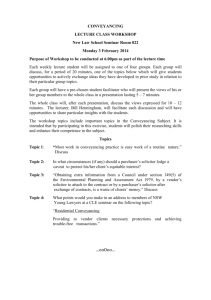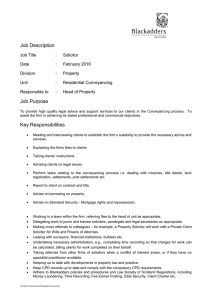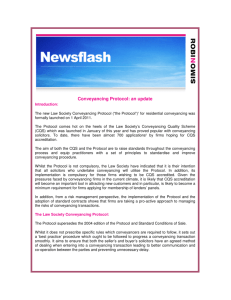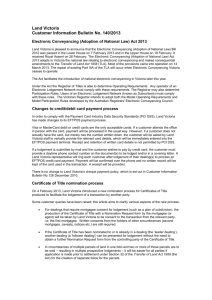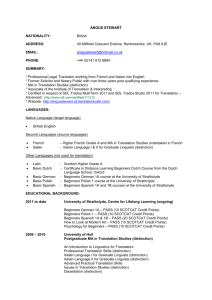Introductory Paper (DOCX 71.0 KB)
advertisement
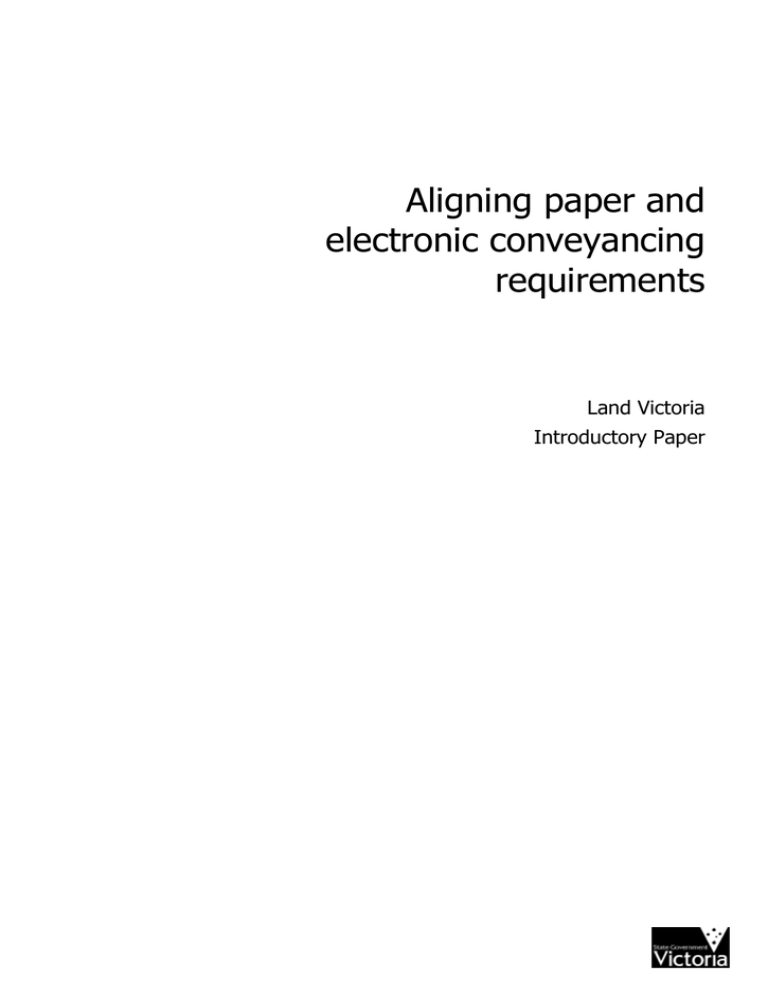
Aligning paper and electronic conveyancing requirements Land Victoria Introductory Paper Department of Transport, Planning and Local Infrastructure Version: 1.0, October 2013 Authorised by Registrar of Titles, Land Victoria Department of Transport, Planning and Local Infrastructure 570 Bourke Street Melbourne Victoria 3000 Telephone (03) 8636 2010 © Copyright State of Victoria, Department of Transport, Planning and Local Infrastructure 2013. Except for any logos, emblems, trademarks, artwork and photography this document is made available under the terms of the Creative Commons Attribution 3.0 Australia license. This document is also available in an accessible format at www.dtpli.vic.gov.au >Land titles>Publications Disclaimer This publication has been prepared for discussion purposes and to elicit stakeholder feedback. It may not necessarily reflect the final policy outcome. Aligning paper and electronic conveyancing requirements Page 2 of 10 Department of Transport, Planning and Local Infrastructure Table of contents 1 Introduction ........................................................................................................................ 4 2 Key stakeholders ................................................................................................................. 4 3 Background ......................................................................................................................... 5 4 Proposed changes ............................................................................................................... 5 5 4.1 Phasing out of certificates of title ................................................................................ 5 4.2 Application of electronic conveyancing requirements to paper conveyancing .................. 6 4.3 Verification of identity ................................................................................................ 6 4.4 Client authorisation .................................................................................................... 6 4.5 Certifications .............................................................................................................. 7 4.6 Priority notices ........................................................................................................... 7 Other matters...................................................................................................................... 8 5.1 Consents ................................................................................................................... 8 5.2 Members of the public ................................................................................................ 8 5.3 Mortgage provisions ................................................................................................... 8 6 Building blocks .................................................................................................................... 8 7 Outline of the consultation process ....................................................................................... 9 8 Consultation timetable ......................................................................................................... 9 9 Obtaining the Consultation Paper and details of the information session ................................. 9 10 How to make a submission ................................................................................................. 10 Aligning paper and electronic conveyancing requirements Page 3 of 10 Department of Transport, Planning and Local Infrastructure 1 Introduction Land Victoria is commencing a public consultation process on aligning paper and electronic conveyancing requirements, and as far as practicable, adopting uniform national requirements to minimise inconsistencies between jurisdictions. This consultation process will also consider a small number of changes to mortgage provisions. The public consultation process will include the forthcoming release of a Consultation Paper outlining proposed changes to conveyancing requirements, and an invitation to stakeholder groups to provide feedback on the proposals in the Consultation Paper. The purpose of this Introductory Paper is to: provide a high level overview of the areas that will be covered in the Consultation Paper; • outline the consultation process; • outline the timetable for consultation; • give details on how to obtain copies of the Consultation Paper, access the information session and gain further information about the consultation process; and • give details on how to make a submission on the issues outlined in the Consultation Paper. Land Victoria, within the Department of Transport, Planning and Local Infrastructure, manages the Victorian Government’s program for land administration and property information. Land Victoria’s responsibilities include the operation of the Victorian Land Registry, which provides land registration services under the Transfer of Land Act 1958. Land Victoria is committed to open, accountable and responsive decision-making, informed by effective communication and consultation between Land Victoria and key stakeholders. The purpose of the consultation process is to seek stakeholder views on Land Victoria’s proposed approach to aligning paper and electronic conveyancing requirements and adopting uniform national requirements. The proposed policy changes outlined in this Introductory Paper and the forthcoming Consultation Paper reflect Land Victoria’s proposed approach. The Victorian Government will not reach a final position on these issues until after the consultation process has concluded. 2 Key stakeholders Relevant stakeholders include, but are not limited to: conveyancers; financial institutions and other mortgage providers; information and search brokers; legal practitioners; professional indemnity and fidelity fund insurers; and relevant government departments and agencies. Aligning paper and electronic conveyancing requirements Page 4 of 10 Department of Transport, Planning and Local Infrastructure 3 Background Traditionally, conveyancing in Victoria was accomplished by the relevant parties physically lodging documents with Land Victoria; this is known as ‘paper conveyancing’. Since 2007 ‘electronic conveyancing’ (where conveyancing is accomplished by electronically submitting documents to Land Victoria) has also been available in Victoria. Currently, only a small percentage of conveyancing transactions are accomplished electronically; however, this is expected to substantially increase in the near future when national electronic conveyancing becomes fully operational. A sizeable percentage of conveyancing transactions will still be completed through paper conveyancing for the foreseeable future. The introduction of electronic conveyancing has resulted in different practices and requirements for paper and electronic conveyancing. Land Victoria’s preference is to have one set of requirements covering both paper and electronic conveyancing transactions. This would facilitate a smooth transition and efficiencies between the two lodgement mediums. It would also avoid complexity and costs to the conveyancing industry, in dealing with two separate processes and requirements. In looking at the alignment of paper and electronic processes, the forthcoming Consultation Paper will consider what safeguards would be needed to enable the phasing out of certificates of title for all property transactions, both paper and electronic, so that the integrity of the Torrens system is maintained. The following sections of this introductory paper provide an overview of what will be covered in the forthcoming Consultation Paper, including the phasing out of certificates of title, additional safeguards and other related matters. This introductory paper also outlines the timelines, process for consultation with industry representative groups and details of the information session. 4 Proposed changes 4.1 Phasing out of certificates of title Currently, for almost every conveyancing transaction, the relevant certificate of title must be produced to enable the transaction to proceed. The certificate of title must also accompany the instruments lodged for registration at Land Victoria. The certificate is seen to perform a number of functions including: acting as a baton to pass control of the certificate of title from one party to another at the time of settlement; and acting as a safeguard against multiple sales of the same parcel of land. In the current environment, the certificate of title is often the only document that is used to identify owners. While possession of the certificate of title is treated as evidence of ownership and hence the right to deal, it does not prove that the person transacting with the property is the person named in the Register of land as the registered proprietor; it only shows that person has access to the certificate of title. Despite the inherent weakness in the reliance on certificates of title, the perception of their importance in a conveyancing transaction is seen to contribute to the control of fraudulent transactions. Aligning paper and electronic conveyancing requirements Page 5 of 10 Department of Transport, Planning and Local Infrastructure The need to use paper certificates of title in an electronic conveyancing system prevents the creation of a fully automated system. Therefore, the removal of the paper certificate of title was a necessary element of an electronic conveyancing system and was achieved through the implementation of alternative safeguards ensuring the integrity of the electronic conveyancing system. In Victoria, this included the implementation of the concept of an electronic certificate of title and functionality to convert paper certificates of title to electronic certificates of title, and functionality to nominate electronic certificates of title to electronic and paper conveyancing transactions. The Consultation Paper will review whether other safeguards are more efficient and effective in maintaining the integrity of the Torrens system and therefore enable the complete removal of certificates of title, now or in the future. 4.2 Application of electronic conveyancing requirements to paper conveyancing The Participation Rules for electronic conveyancing determined by the Registrar of Titles under the Electronic Conveyancing National Law (Victoria) set out the requirements for verification of identity, client authorisation and certifications. It is proposed that these same requirements will also apply to paper conveyancing transactions. It is also proposed to implement priority notices for both electronic and paper conveyancing transactions. The Participation Rules are available at www.dtpli.vic.gov.au >Land titles>Publications 4.3 Verification of identity While the certificate of title is currently often the only document used as evidence of ownership, upon its removal a robust regime of verification of identity will be required. It is proposed that the electronic conveyancing verification of identity requirements set out in Rule 6.5.1 of the Participation Rules will also apply to paper conveyancing transactions. This will require the conveyancer, legal practitioner and mortgagee to take reasonable steps to verify the identity of their client or customer. Compliance with the Verification of Identity Standard (the VOI Standard) set out in Schedule 8 of the Participation Rules will be deemed to constitute taking reasonable steps. It is possible that both the rule and the VOI Standard may require minor adjustments to accommodate paper transactions. The conveyancer and legal practitioner will also need to take reasonable steps to verify the identity of each of their employees who will be signing paper conveyancing transactions on behalf of their client. 4.4 Client authorisation It is proposed that client authorisation requirements for electronic conveyancing as set out in Rule 6.3 of the Participation Rules will also apply to paper conveyancing transactions. This will require the conveyancer and legal practitioner to enter into a client authorisation with their client. The introduction of client authorisations in both the paper and electronic environments will allow a smooth transition between the two lodgement mediums for conveyancers and legal practitioners. This is because, initially at least, the conveyancer or legal practitioner may not know whether a particular transaction is going to progress in paper or electronically. The conveyancer and legal practitioner will also need to take reasonable steps to establish that the client is entitled to enter into the conveyancing transaction identified in the client authorisation. Reasonable steps could include obtaining some form of proof that ties the client’s identity to the land Aligning paper and electronic conveyancing requirements Page 6 of 10 Department of Transport, Planning and Local Infrastructure in the transaction. The client authorisation will authorise the conveyancer or legal practitioner to act as the client’s agent and sign paper conveyancing transactions on their behalf. The client authorisation form included in Schedule 4 of the Participation Rules is currently being revised (including making it suitable for both paper and electronic conveyancing transactions) by Australian Registrars' National Electronic Conveyancing Council (ARNECC) in consultation with industry peak bodies. 4.5 Certifications It is proposed that the electronic conveyancing certification requirements set out in Rule 7.10 of the Participation Rules will also apply to paper conveyancing transactions. This will require the conveyancer, legal practitioner and mortgagee to provide certifications for each paper conveyancing transaction to be lodged. The certifications are set out in Schedule 3 of the Participation Rules. Conveyancers, legal practitioners and mortgagees must give the certifications in their own right, regardless of whether they are acting for themselves or a client in the transaction. A benefit of this requirement is to give conveyancers, legal practitioners and mortgagees greater certainty when they deal with other parties to a property transaction. 4.6 Priority notices It is proposed that priority notices will be implemented for both paper and electronic conveyancing transactions. Priority notices, or settlement notices, can currently be lodged in Tasmania and Queensland. Other jurisdictions are now considering implementation of priority notices. A priority notice, when lodged with the Registrar of Titles, seeks to provide protection to a party gaining an estate or interest in land (for example, a transferee or a mortgagee) against the lodgement of dealings not specified in the priority notice. This protection will be effective between the time of the lodgement of the priority notice and the later lodgement of the conveyancing transaction at Land Victoria. A priority notice, once lodged, alerts all interested parties who search the Register to the fact that lodgement of a conveyancing transaction is imminent. Priority notices will operate for a specified period. During this period, a priority notice will prevent processing of most other conveyancing transactions affecting the land or interests in the land, other than those complying with a defined set of criteria. The introduction of a priority notice strengthens the current settlement and lodgement processes. It means that industry can settle and lodge their transactions with full confidence of the priority of their transaction. Land Victoria considers the introduction of priority notices an important safeguard in lieu of certificates of title. Priority notices will replace the role of the certificate of title as a unique baton until registration. The lodgement of a priority notice will protect the interest of the parties to the transaction, ensuring that another competing transaction dealing with the same estate or interest does not gain priority. It will also prevent multiple settlements of the same property because a person searching the Register will be notified that there is already a pending transaction on that folio. Aligning paper and electronic conveyancing requirements Page 7 of 10 Department of Transport, Planning and Local Infrastructure 5 Other matters 5.1 Consents Land Victoria considers that the Transfer of Land Act 1958 should be amended so that consents from third parties, such as a first mortgagee, need not be submitted to the Registrar of Titles for dealings under the Transfer of Land Act 1958. Instead, it is proposed that there will be a new legislative provision under which any subsequent dealing with an estate or interest is not binding on a mortgagee, if the mortgagee has not consented to it. It is further proposed to simplify sections 77(4) and 90(1) of the Transfer of Land Act 1958. However, this will be the subject of detailed consultation with financial institutions and other stakeholders. 5.2 Members of the public There are a small number of conveyancing transactions undertaken each year by members of the public. Land Victoria will give consideration to the requirements and processes for members of the public and the application of the safeguards outlined in Section 4. 5.3 Mortgage provisions The Registrar of Titles proposes to introduce legislative provisions similar to those in operation in Queensland and New South Wales, where a mortgage will be void if a mortgagee fails to take reasonable steps to verify the identity of the mortgagor. In addition, where a mortgagee takes reasonable steps to verify the identity of a mortgagor but the mortgage is otherwise fraudulent, the rate of interest payable will be limited to a rate that represents the actual borrowing costs incurred by the mortgagee (for example, the Reserve Bank of Australia's official cash rate or the Banks Accepted Bills rate). 6 Building blocks The following diagram sets out the building blocks for achieving the alignment of paper and electronic conveyancing requirements. Aligning paper and electronic requirements Verification of identity Client authorisation Certifications Priority notices Phasing out certificates of title Legal framework Aligning paper and electronic conveyancing requirements Page 8 of 10 7 Outline of the consultation process This Introductory Paper gives a high-level introduction to the topic of aligning paper and electronic conveyancing processes (a copy of this paper is available at www.dtpli.vic.gov.au >Land titles >Publications). In November 2013 Land Victoria will release a Consultation Paper outlining in detail specific issues related to aligning paper and electronic conveyancing processes. This paper will be available at www.dtpli.vic.gov.au >Land titles>Publications and will be emailed directly to key industry bodies. The release of this paper will be followed by an information session. Industry groups and the wider public will also be offered the opportunity to make written submissions to Land Victoria outlining their views. Submissions should be made to Land Victoria by 1 February 2014. Following consideration of the responses from stakeholders received in response to the Consultation Paper, Land Victoria will issue a response to the submissions from stakeholders. The submissions from stakeholders will inform Land Victoria’s recommendations to the Minister for Planning on possible legislative reforms. 8 Consultation timetable The proposed timetable for the consultation process is set out below: Paper topic Release date Closing date for submissions from stakeholders Information session Introductory Paper (this paper) October 2013 N/A N/A Consultation Paper November 2013 1 February 2014 Late November Response to submissions from stakeholders March 2014 N/A N/A 9 Obtaining the Consultation Paper and details of the information session The Consultation Paper will be available at www.dtpli.vic.gov.au >Land titles>Publications Details of the information session (time, date, location and advice on how to RSVP) will also be available at the same web address. If you would like a copy of the Consultation Paper and details of the information session emailed to you, please email a request to policy.lv@dtpli.vic.gov.au. Land Victoria will email a copy of the Consultation Paper and advice on the information session to a range of key industry bodies. Aligning paper and electronic conveyancing requirements Page 9 of 10 Department of Transport, Planning and Local Infrastructure 10 How to make a submission Details of how to make a submission (including due dates) will be included in the Consultation Paper. If you would like to provide any high level feedback on this paper it can be emailed to policy.lv@dtpli.vic.gov.au. Alternatively, feedback will be sought and can be provided on the Consultation Paper following its release. Unless requested not to, Land Victoria will treat all submissions received as public documents. Land Victoria reserves the right to make submissions (in part or in full) available to other parties and the general public. Aligning paper and electronic conveyancing requirements Page 10 of 10
